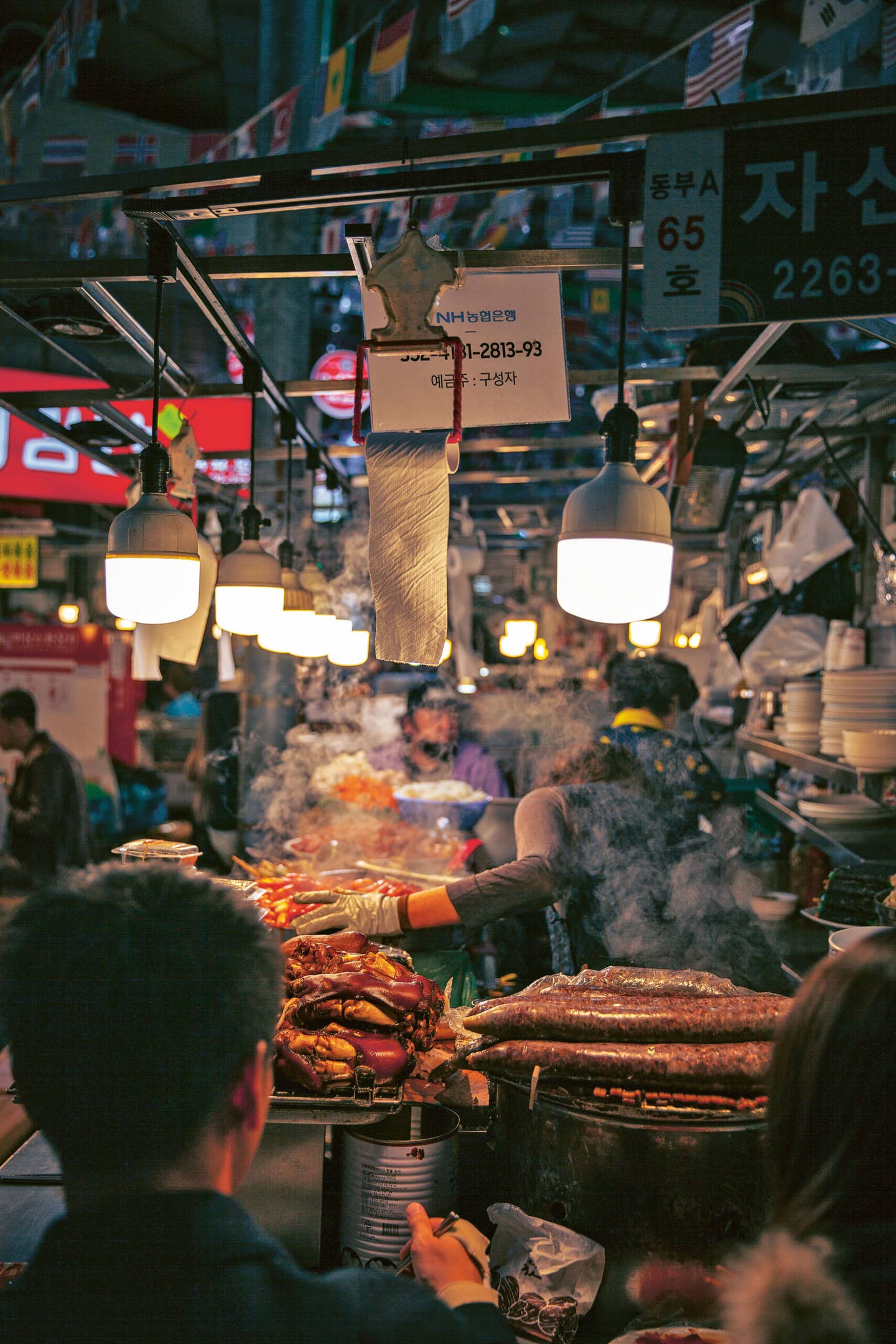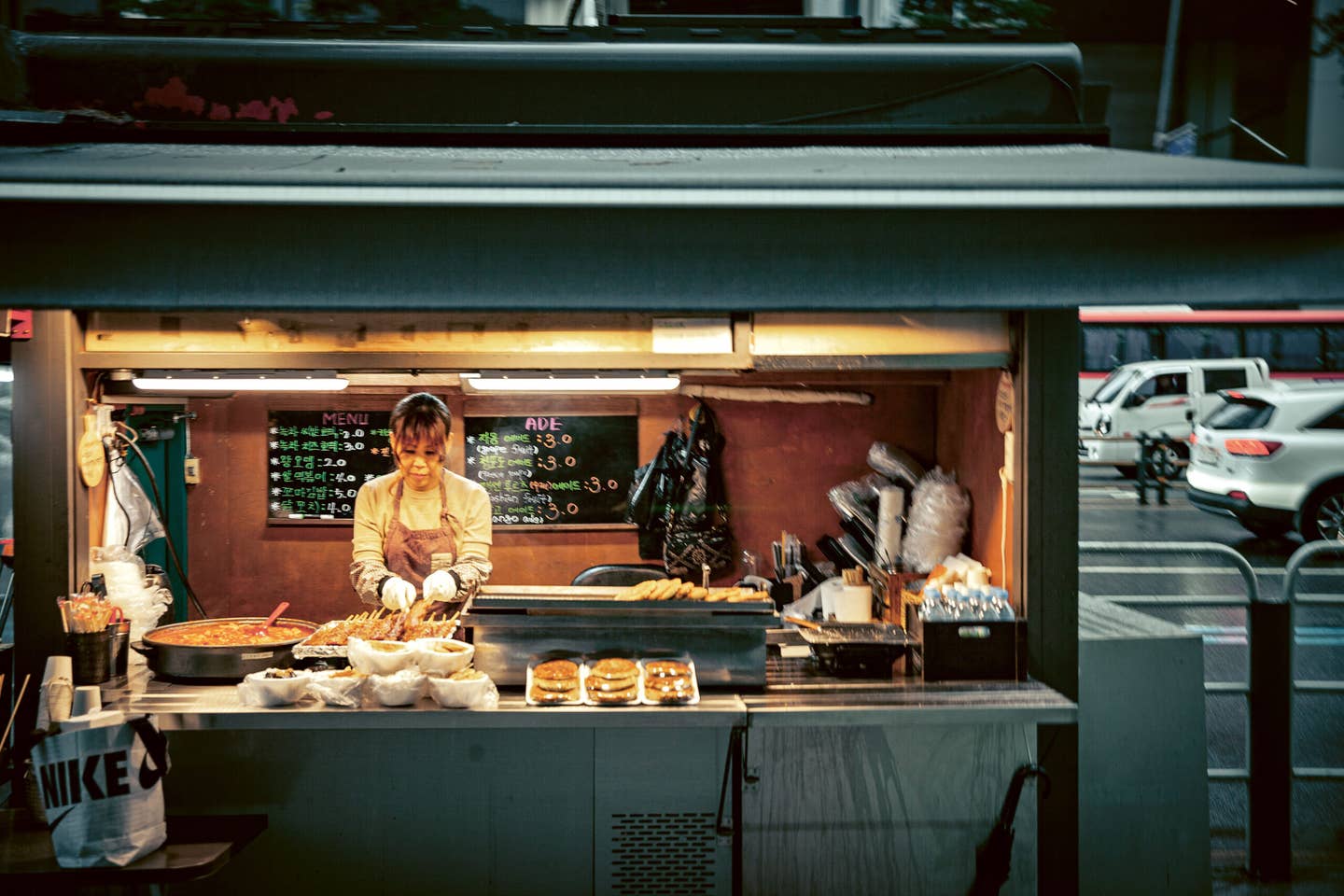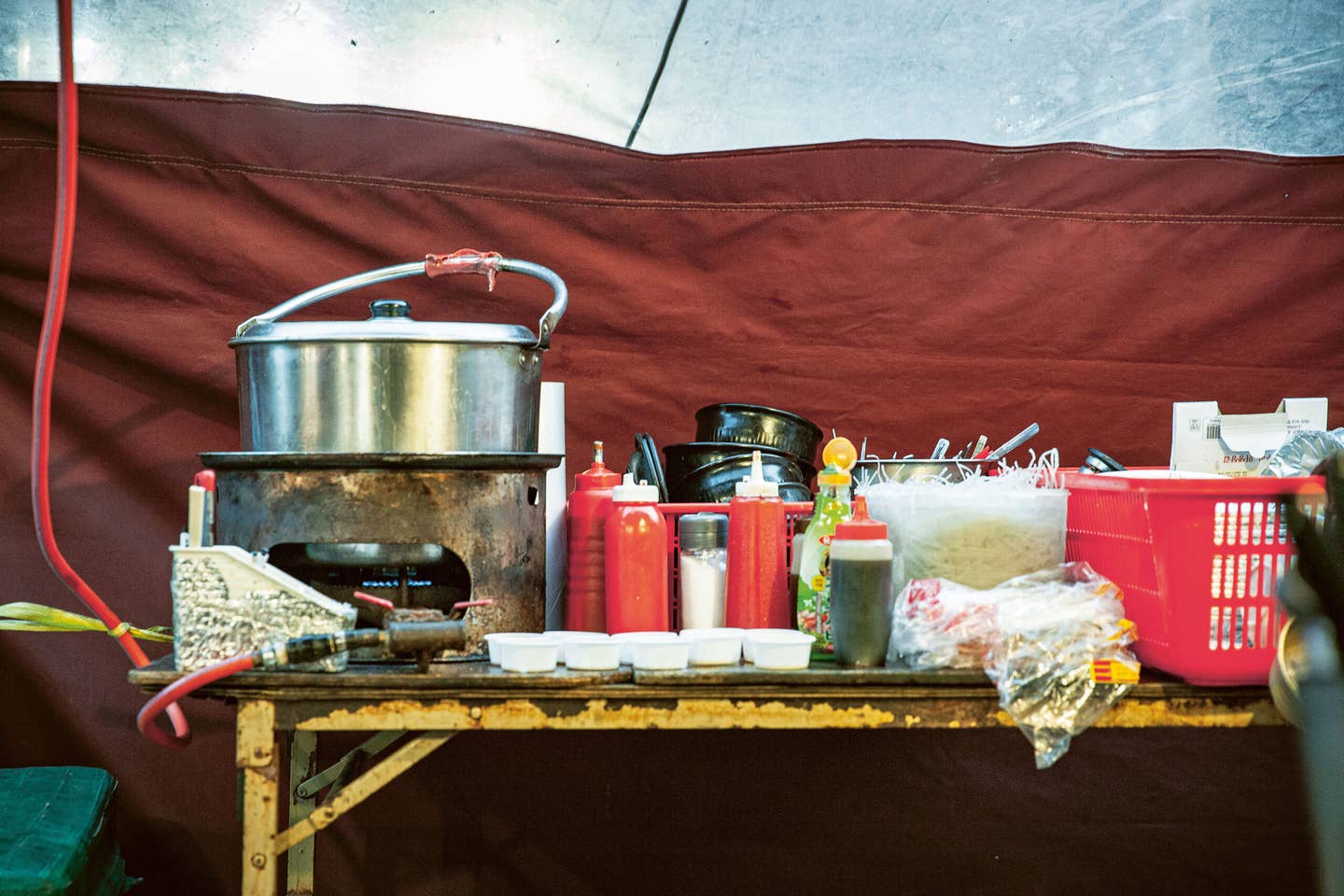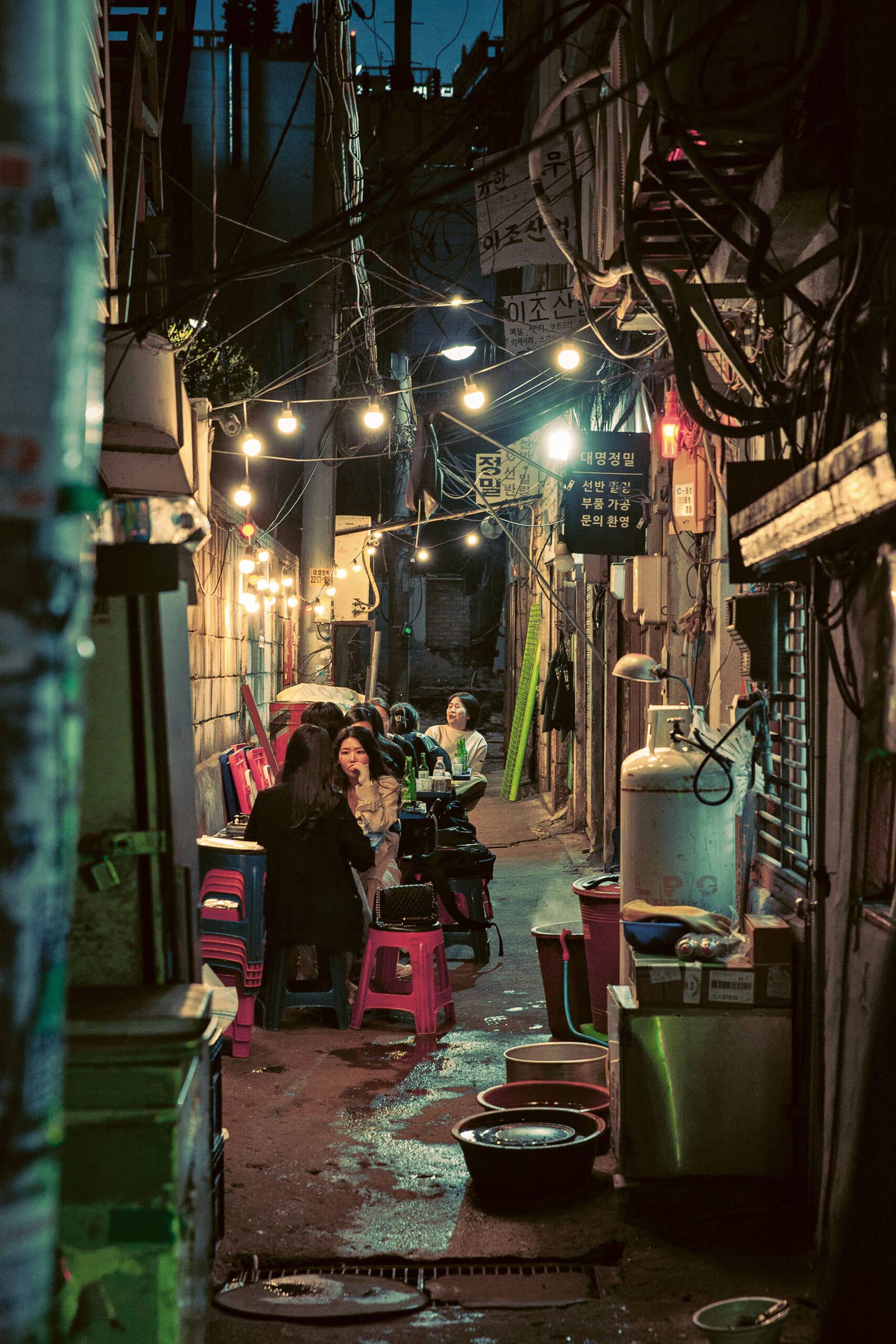This interview is delivered to you by the SAVEUR Cookbook Membership, our passionate group of food-loving readers from across the globe, celebrating our favourite authors and recipes. Be part of us as we prepare dinner by way of a brand new e-book each month, and share your meals pics and vids on social media with the hashtags #SAVEURCookbookClub and #EatTheWorld.
The writer Su Scott describes the pocha marketplaces of Seoul as a sort of theater, and a glimpse into the pages of her new cookbook, Pocha: Easy Korean Meals from the Streets of Seoul, instantly exhibits you why. Pocha stalls—brief for pojangmacha, which interprets to “coated wagon”—usually debut at night time alongside town streets, illuminated by hanging tungsten lights that shine over open grills and scorching skillets. Beneath the drape of crimson and orange tarpaulins, these stands end up a few of Korea’s most iconic avenue meals, be it spicy-sweet gireum tteokbokki (oil-seared rice muffins); bowls of pickled greens; or pastries full of every thing from crimson bean paste to Nutella. Set in opposition to the sound of clinking glasses of soju, it’s an altogether marvelous present for the senses, and a supply of nationwide pleasure. As I spoke with Scott from her dwelling in London, I discovered that her cookbook was an try to seize the magic and theater of the pocha as a way of preservation, each for herself and for all followers of Korean cooking.

What makes pocha meals totally different from that supplied in a Korean restaurant?
Markets are excellent locations for anybody to essentially really feel the lifetime of that specific nation or tradition. On a really fundamental environmental stage, there’s a sound and odor, and it’s simply sensory heaven. As you stroll by way of the markets, you see how folks transfer and discuss and have interaction. There’s a affordable diploma of belief as effectively, and you recognize you’re seeing the entire theater of it because it unfolds. What’s totally different is the best way that the meals is cooked: The pocha setup could be very easy; there’s no set of six burners, only one hob. The dishes are very seasonal, based mostly on what’s out there and low-cost, however carried out very effectively. However it occurs in entrance of you, and there’s a direct connection that you’ve with the seller. For the cooks, whereas they’ve years of expertise, their meals doesn’t have ego. However there’s a sense of pleasure—that is their life, and so they wish to feed you effectively, and so that you can prefer it. And I feel that’s fairly particular.

How did pocha go from a working-class expertise to at least one beloved all through Korea? How are they being sustained right now?
In Korea, nearly everybody can afford good meals, and even the richest folks will queue up for a restaurant’s particular dish for 2 hours or extra. Korea solely got here out of meals poverty after the Korean Struggle, so numerous older generations perceive what it means to be hungry, and there’s a lot of affection for preserving Korean meals and its tradition. As Korea has developed into a world powerhouse, Korean meals firms are taking on area on this planet market. Now, a few of the neighborhoods that home pocha are being redeveloped; there are elements of Seoul I don’t even acknowledge anymore. But what I’m seeing now could be that youthful generations who’re transferring into these soon-to-be-demolished cities wish to protect these locations. So I’m assured that pocha will live on, although in what form or kind is one other story. However I feel the educated, youthful generations convey savvy and eloquence to the combat to guard their tradition.
How did you get into meals writing?
Round 2011, meals blogs have been in every single place, and I keep in mind studying meals blogs equivalent to Cannelle et Vanille and Orangette, and considering, “Oh, I actually wish to try this.” So I wrote a extremely unhealthy meals weblog, after which I in some way secured a job writing a column for a Korean meals journal, and it felt like a follow to search out out what I wish to write about. When my daughter was born in 2015, I noticed that I’d lived in London lengthy sufficient that I had distanced myself from Korean tradition. So I began to discover the place my Koreanness comes from, and probably the most tangible factor was meals and the dishes that I grew up with. And in 2019, the Observer Meals Month-to-month ran a contest for readers’ recipes, and I entered with a narrative about my mom’s kimchi jjigae, and to my shock, I received. That second crystallized what I needed to do, and that turned my first e-book, Rice Desk, all about my mom’s and maternal grandmother’s tables and the way what we feed ourselves builds the larger image of who we’re.
Some folks could also be stunned to see elements equivalent to cheese and sizzling canine (or each, within the case of your recipe for corn canine) on this e-book. How did these elements enter the pantheon of Korean cooking?
Going again to the period of the Three Kingdoms of Korea [18 BCE–660 CE], we have been influenced by all these neighboring international locations, and a few of the similarities between Chinese language and Korean cuisines stems from that interval of commerce. Then we had the Japanese occupation [1910–1945], and that introduced the affect of Japan together with migrant employees from Japan and China. There are numerous crossovers that we are able to’t, whilst Koreans, fairly pinpoint. Did a dish begin with us, or did it come from Japan and was then reimagined in Korea as it’s now? Then the Korean Struggle introduced American and European troopers, and lots of Koreans relied on the generosity of American troops passing on rations that they didn’t need; one group’s waste turned one other’s treasure, and it sustained the nation in so some ways. Substances equivalent to Spam or canned beans or American cheese have been tailored to go well with Korean palates. While you take a look at the very latest historical past of Korean meals, it’s important to keep in mind that free journey actually solely began within the early Nineteen Eighties, and we welcomed an inflow of vacationers through the [1988 Seoul] Olympics, so it was a basic time of progress in all areas, however notably in meals. Now, Koreans aren’t simply going to the U.S.; they’re going to Europe to review and to study meals, and so they convey quite a bit again with them. So what as soon as appeared like a fairly restricted possibility—Korean folks eager to protect Korean meals—now seems to be totally different.
How would you clarify the numerous gradations of taste and texture in Korean delicacies?
We now have this concept of bapsang, a desk that features a variety of dishes—banchan, a bowl of rice, and both soup or stew—one thing with a heat broth. The remainder of the meal helps the rice; there’s a saying that each Korean guardian is aware of: “rice is life.” That concept comes from the generations who by no means had sufficient meals. However we wish to take pleasure in quite a lot of issues, and we’re additionally very acutely aware of meals as a type of drugs. There are additionally numerous totally different colours, textures, and temperatures to fulfill and steadiness. I feel the steadiness is an important factor—the harmonious desk. Korean persons are actually good with being acutely aware and conscientious towards nature as a result of we needed to be taught to protect meals, and preserving brings a special texture. So when anybody asks me to pinpoint “What’s Korean meals?” I say, “concord.”

Pocha meals is sort of all the time loved with a drink of soju, both by itself or in a cocktail equivalent to a Soju Bitter. Why is that so very important?
So within the Sixties to ’70s, there was an enormous shift in Korea towards eager to rebuild the nation. Seoul turned this place the place every thing was potential; folks got here with their goals, and pocha supplied a spot of relaxation to those employees coming from all walks of life after a tough day’s work—and there was all the time soju. So each have been booming on the similar time, and so they have this actually pretty symbiotic relationship. It’s a bit just like the pub tradition within the UK—after work you’ve gotten a drink along with your colleagues or associates and also you offload the weights of life. We work exhausting, so we play exhausting; we drink soju and drown our sorrows so we are able to face the world once more tomorrow with rejuvenated vitality and vitality. After which that comes with the tradition of hangover remedy; you could sober up and begin once more, and there’s no time to waste.

The e-book’s meals and journey pictures are so vibrant. How did you identify the appear and feel of the e-book?
I used to be very fortunate—my husband is a meals photographer, so he’s all the time labored within the trade. One sizzling summer season night time, we have been in Busan at a pocha, and we have been sort of tipsy, and we had this epiphany of the vibe we needed within the e-book and doodled the duvet collectively. It needed to have neon lights and darkness and coziness and ease, however alongside the calm and serenity and mundanity of what Seoul can really feel like in case you’re not a vacationer. In the event you dwell on these untrodden paths, you possibly can seize a way of employees breaking for lunch, folks gathering in a park on a sizzling summer season’s day, with tents and cans of beer, to look at the world go by. So we lived this concept of pocha at dwelling in London, and once we went again to Korea to take images, particularly the placement images, I’d already made a listing of 250 random issues that I needed to seize, and for about two weeks we walked in every single place to cowl all of the fundamentals. I’m past happy with the images within the e-book as a result of it’s precisely what I needed—for folks to really feel like they’re strolling with me.
Did you’ve gotten any favourite recipes or parts within the e-book to develop?
Oh God, there are such a lot of! I’m not valuable about household recipes as a result of I didn’t have household recipes as such. However the Northern-style dumpling, I keep in mind how we made it at dwelling, and my father was fairly robust about maintaining with the custom as a result of he grew up consuming these dishes. It’s additionally the primary dish that my daughter requested me to prepare dinner together with her, and he or she took such pleasure in making and shaping the dumplings. That is the ability of meals, that one recipe permitting her to have interaction with the tradition and to embrace my household, who she doesn’t see fairly often. I took a video of once we made that dish for the primary time collectively, and I despatched it to my father. He cried and felt that sense of pleasure.




